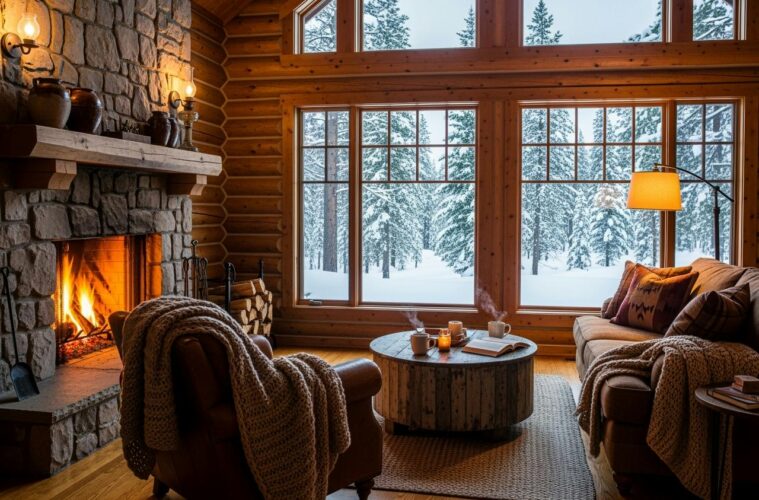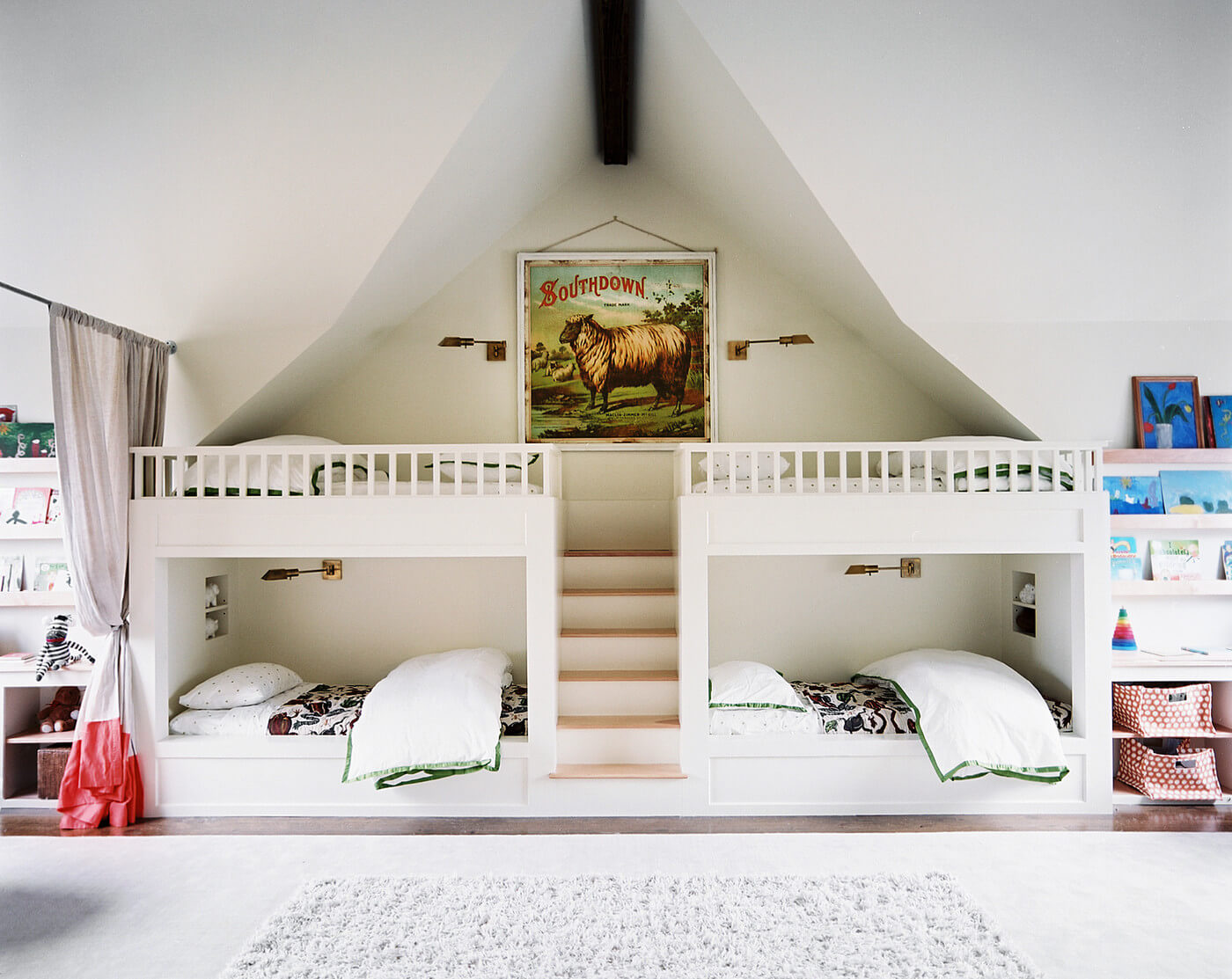Imagine a place where warmth wraps around you like a favorite blanket. A crackling fire glows softly. Snow falls gently outside large windows. This is the magic of a log cabin living room. These spaces are more than just rooms. They are cozy sanctuaries. They connect us to nature and offer true comfort.
In this guide, we will explore what defines this unique aesthetic, uncover the essential elements for creating a rustic and inviting space, and learn how to blend traditional charm with modern comforts. From timeless rustic to chic contemporary, log cabin living rooms offer endless design possibilities for a cozy retreat.
Get ready to transform your living space. We will help you create a log cabin living room that feels like a perfect hideaway.
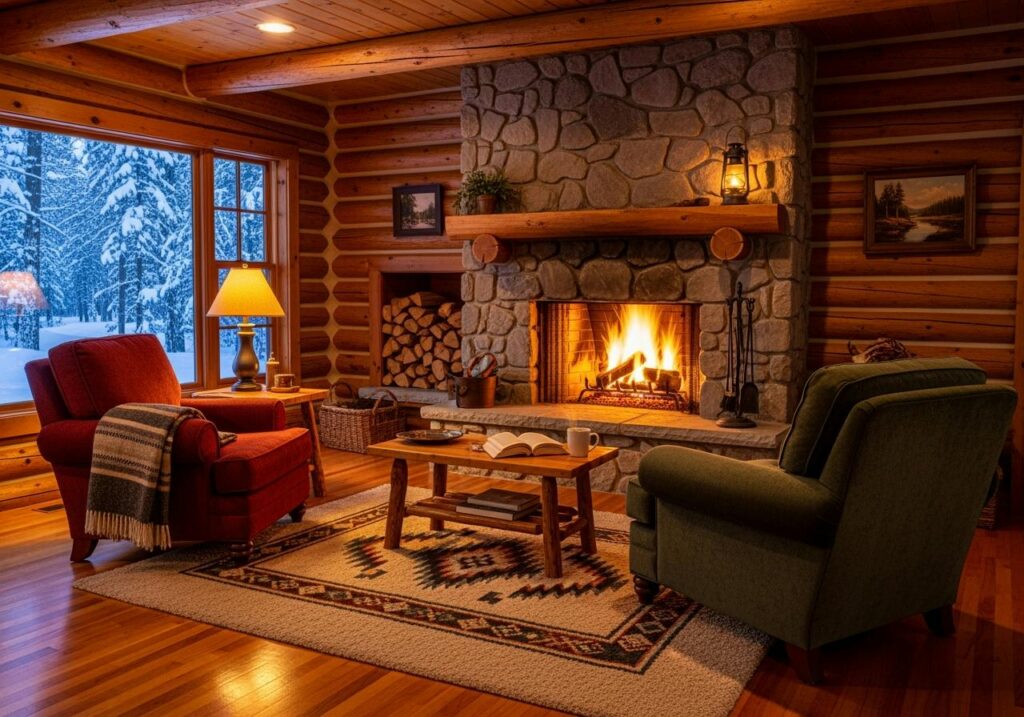

The essence of a log cabin living room begins with its very structure. These spaces are inherently defined by their architectural elements and the natural materials from which they are built. The raw beauty of exposed wood, often in the form of substantial log walls, immediately sets a rustic and authentic tone. Whether hand-hewn or milled, these logs tell a story of craftsmanship and connection to the natural world.
Beyond the walls, vaulted ceilings are a familiar and cherished feature, drawing the eye upwards and creating a sense of grandeur and spaciousness. These soaring ceilings are frequently adorned with exposed beams, which add structural integrity and contribute significantly to the room’s rustic charm. The interplay of light and shadow on these wooden surfaces creates a dynamic and
inviting atmosphere.
A cornerstone of many log cabin living rooms is the fireplace. More than just a heat source, it serves as a central focal point, a gathering place, and a symbol of warmth and comfort. These can range from grand stone fireplaces, built from local river rock or quarried stone, to more minimalist designs that still command attention. The natural textures and colors of the stone perfectly complement the wood, grounding the space in its natural surroundings. Exploring the
charm of original log cabin home designs can provide deeper insights for those looking to understand how these fundamental elements come together to create inviting spaces.
The choice of wood itself plays a crucial role in the overall aesthetic. With its distinctive knots and lighter hue, Pine offers a classic, bright cabin feel. Cedar has a rich aroma and a reddish tone, often associated with durability and natural resistance. Cypress, known for its resilience and unique grain, can impart a sense of timeless elegance. Each wood type’s character influences the room’s warmth and visual texture.
Finally, large windows are not merely functional but integral design elements. They frame the surrounding natural views, whether a dense forest, a serene lake, or snow-capped mountains, effectively bringing the outdoors in. This connection to nature is a defining characteristic of log cabin living, making the living room a seamless extension of its environment. The strategic placement of these windows maximizes natural light, essential for illuminating the rich wood tones and preventing the space from feeling too dark or enclosed.
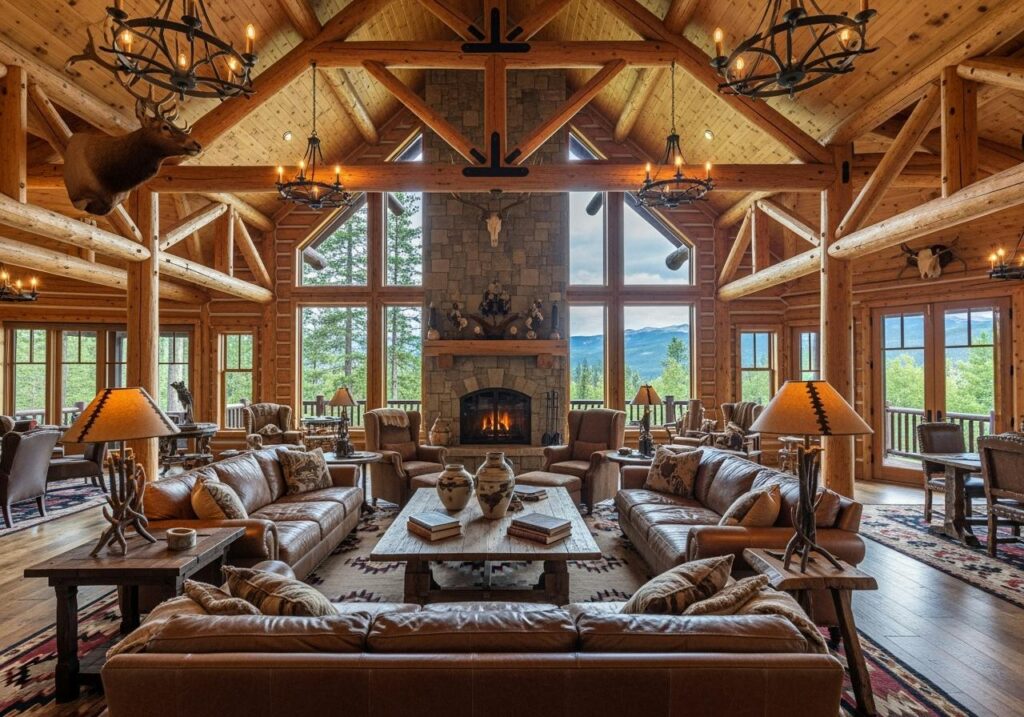
Crafting Ambiance in Premium Log Cabin Living Rooms
Creating the perfect ambiance in a log cabin living room is an art that balances the inherent rustic charm with thoughtful design choices. It’s about more than just filling a space; it’s about curating an experience that feels both luxurious and genuinely welcoming. For those seeking inspiration and detailed examples of beautifully designed spaces, a visit to Log Cabin Homes premium living rooms can offer a wealth of ideas.
Layered lighting is paramount in these spaces, changing them from merely functional to truly atmospheric. Streaming natural light through those expansive windows is the first layer, connecting the interior to the external landscape. Beyond daylight, the strategic placement of various light sources ensures warmth and depth after dusk.
Fuss-free furniture, characterized by its comfort and durability, is key. We aim for pieces that invite relaxation without being overly delicate or formal. This approach allows the natural beauty of the cabin’s structure to shine, while the furniture provides an anchor of comfort. Creating distinct zones within the living room, especially in larger open-plan cabins, helps to define areas for different activities, from intimate conversations by the fire to larger family gatherings.
Essential Furnishings for Your Premium Log Cabin Living Room
Understanding scale is crucial when furnishing a premium log cabin living room. Log homes often feature grand proportions, with high ceilings and substantial log walls. Too small furniture can feel lost in these vast spaces, resembling “dollhouse furniture.” We recommend choosing pieces with a generous scale that can comfortably hold their own.
Comfortable seating is non-negotiable. Think deep, plush sofas and armchairs that invite you to sink in and relax. Leather sofas, with their rich texture and ability to age beautifully, are a classic choice, offering both durability and a touch of rugged elegance. Upholstered armchairs in natural
fabrics provide softness and can introduce subtle patterns or colors.
Natural textiles are your allies in enhancing comfort and visual appeal. Wool blankets are perfect for chilly evenings with their warmth and texture. Faux fur throws add a touch of luxury and coziness, while plaid throws introduce classic cabin patterns. Layering these textiles on sofas and chairs creates an inviting look. Area rugs are also essential; they define seating areas, add warmth underfoot, and introduce color and pattern. When considering the overall aesthetic for
your cabin, a guide to decorating your log cabin home with rustic elegance can provide valuable insights into selecting these elements.
The Art of Illumination
Lighting in a log cabin living room is not just about functionality; it's about creating mood and highlighting the unique architectural features. We approach illumination with a layered strategy, combining ambient, task, and accent lighting. Dimmers are indispensable, allowing you to adjust light intensity to suit any occasion, from bright and lively to soft and romantic. Ambient lighting provides the room’s overall glow. This can come from large chandeliers, which
often serve as stunning focal points, or recessed lighting integrated into vaulted ceilings. Antler and wrought iron fixtures are popular choices that perfectly complement the rustic aesthetic, adding an organic or handcrafted touch.
Task lighting is focused on specific activities, such as reading. Floor lamps placed next to armchairs or table lamps on side tables provide this directed light. Accent lighting is used to highlight architectural details, artwork, or the texture of the log walls. Wall sconces can warmly glow along the logs, emphasizing their texture, while strategically placed spotlights can draw attention to a prized art piece or a stone fireplace. For a deeper dive into how different fixtures can improve your cabin’s glow, exploring illuminating charm with light fixtures in your original
log cabin home is highly recommended.
Color Palettes Inspired by Nature
The natural wood tones of a log cabin provide a warm and rich foundation for any color palette. We aim to choose colors that complement this natural backdrop, enhancing the sense of warmth and connection to the outdoors.
Earthy tones are a natural fit, echoing the landscape outside. Warm neutrals like creams, beiges, and shades of brown create a serene and cohesive environment. Sage green is a remarkably harmonious choice, reflecting the greens of the forest and providing a subtle contrast to the wood.
While the primary palette leans towards neutrals, accent colors can add depth and personality. Deep reds, reminiscent of autumn leaves or a cozy plaid, can inject warmth and energy. Forest greens bring in the vibrant life of the woods, while navy blues can introduce a touch of sophisticated calm, evoking mountain lakes or twilight skies. For those interested in best integrating these hues, exploring interior colors for classic log cabin living offers comprehensive guidance. Monochromatic schemes, using different shades and tints of a single color, can also create a sophisticated and cohesive look, allowing the textures of the wood and textiles to come
to the forefront.
The Modern Rustic Evolution: Blending Old and New
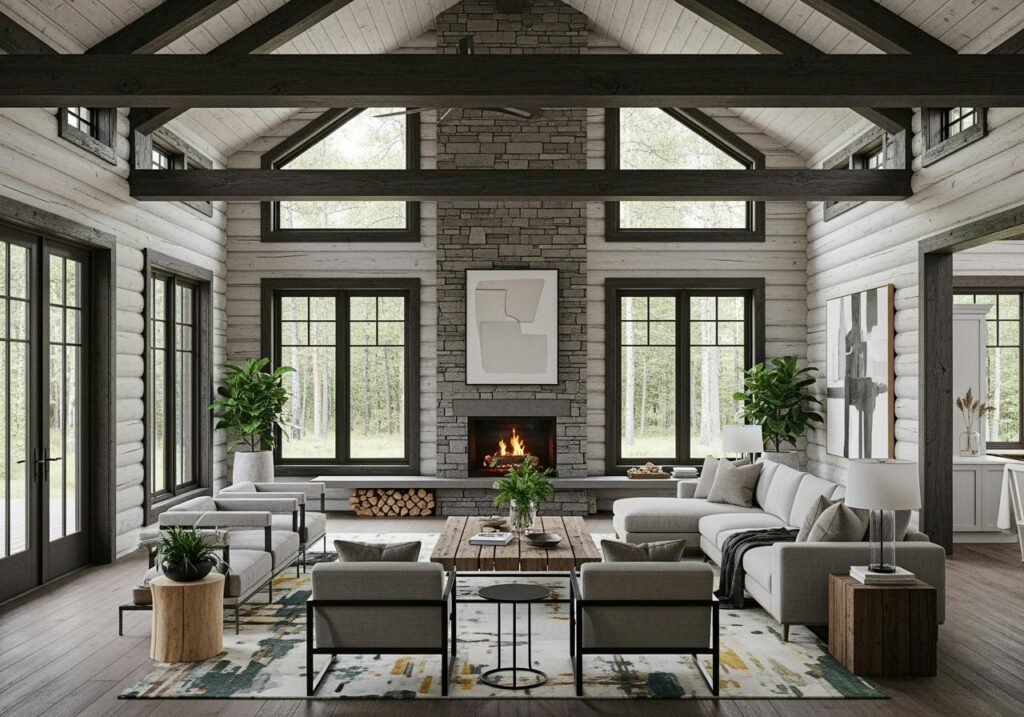
design. It’s about creating spaces deeply rooted in tradition and effortlessly current. Imagine a log cabin living room where the classic log walls are softened by strategically placed white plaster or dark, prominent beams are contrasted with light, overstuffed sofas. This interplay of old and new creates a visually compelling space that avoids feeling dated or overly themed. The goal is a harmonious balance, where each element improves the other, resulting in a living room that is both cozy and chic. For a visual journey into how these elements come together, this modern log cabin living room showcases a perfect example of blending old and new.
Modernizing Your Premium Log Cabin Living Room
Modernizing a log cabin living room while retaining its charm is a delicate balance. We achieve this by thoughtfully introducing contemporary elements that complement, rather than detract from, the rustic foundation.
One of the most effective strategies is using contrasting colors. Where dark wood might dominate, we can introduce shades of white, cream, or light gray through furniture, textiles, or even painted architectural features. Whitewashed wood, applied to ceilings, beams, or even some log walls, can dramatically lighten a space, making it feel more expansive and airy. Similarly, plaster finishes can soften the intensity of wood, offering a smooth, neutral surface that provides
a welcome visual break.
Modern art, with its clean lines and abstract forms, can offer a striking contrast against the natural textures of the logs. Sculptural furniture pieces, such as a sleek, rounded sofa or an angular coffee table, introduce contemporary forms that stand out beautifully without clashing. Metallic accents, like steel or copper light fixtures, hardware, or decorative objects, add a touch of industrial chic or refined glamour, reflecting light and a modern edge. To truly understand the impact of these choices, considering the aesthetic implications of light vs. dark colored wood in your log cabin home is invaluable.
Traditional vs. Modern Design
Understanding the distinct characteristics of traditional and modern log cabin living rooms helps you craft your desired aesthetic. While both accept the warmth of wood, their approaches to design diverge significantly.
Here are key differences:
- Wood Finish:Traditional: Often features darker stains, highlighting the natural grain and knots, creating a rich, aged appearance. Logs may be hand-hewn or rough-sawn, with visible chinking between logs.
- Modern: Tends towards lighter stains, natural finishes, or even whitewashed logs and beams. The emphasis is on clean lines and a smoother, more refined wood surface.
- Furniture Style:Traditional: This style favors sturdy, oversized pieces with a classic rustic or lodge aesthetic. Think leather sofas, heavy wooden tables, and pieces with a visibly handcrafted feel.
- Modern: This style incorporates sleek, minimalist, or sculptural furniture. Upholstery might be in neutral tones, and furniture often features clean lines, sometimes with mixed materials like metal or glass.
- Color Palette:Traditional: It relies heavily on warm, earthy tones—deep browns, forest greens, burgundy reds, and natural creams. Patterns often include plaid, Native American motifs, or wildlife themes.
- Modern: This style accepts a lighter, more neutral palette of whites, grays, and natural wood tones, often with pops of color introduced through art or subtle accents.
- Overall Feel:Traditional: Evokes a sense of cozy retreat, rugged charm, and historical authenticity. It’s often about maximal comfort and a strong connection to pioneer heritage.
- Modern: Aims for a sophisticated, airy, and refined ambiance. It focuses on functional elegance, open spaces, and a seamless blend of natural elements with contemporary living.
Exploring log cabin living offers a comprehensive overview of the diverse styles and experiences within these homes.
Incorporating Handcrafted and Personal Elements
Whether your preference leans traditional or modern, incorporating handcrafted and personal elements makes a log cabin living room unique and soulful. These pieces tell a story and infuse the space with character that mass-produced items simply cannot.
Unique decor, such as a hand-carved wooden sculpture, a pottery collection, or a custom-made textile art piece, can become a focal point and conversation starter. Vintage finds, found at antique markets or passed down through generations, add layers of history and warmth. A worn leather trunk used as a coffee table or an old fishing creel repurposed as storage brings a sense of authenticity.
Local artisan pieces support regional talent and ensure your decor connects with its geographical context. Whether a bespoke dining table or a custom-built bookshelf, handcrafted furniture speaks to quality and individuality. Personal touches, like framed family photographs, travel souvenirs, or a collection of beloved books, transform a house into a home. Combined with family heirlooms, these elements create a living room that is deeply personal and reflective of its
inhabitants. When exploring designs for premium log cabin living rooms, these custom details create a unique space.
Frequently Asked Questions about Log Cabin Living Room Design
We often encounter questions from homeowners eager to perfect their log cabin living rooms. Here, we address some of the most common inquiries to help you steer your design journey.
How do you make a log cabin living room feel brighter?
Log cabins, with their abundant wood, can sometimes feel dark. We recommend several strategies to brighten the space:
- Use light-colored textiles: Opt for sofas, rugs, curtains, and throw pillows in creams, whites, light grays, or pale blues.
- Incorporate mirrors: Strategically placed mirrors reflect light, making the room feel larger and brighter.
- Add layered lighting: Beyond natural light, ensure you have a mix of ambient (overhead), task (reading lamps), and accent (wall sconces, spotlights) lighting, all on dimmers.
- Paint or whitewash some wood surfaces: While a bold step, whitewashing a ceiling or a feature wall can dramatically lighten the room while preserving the wood texture.
- Choose furniture with a lighter visual weight: Instead of heavy, dark pieces, select furniture with exposed legs, lighter frames, or open designs to prevent the room from feeling too heavy.
What furniture style works best in a log cabin?
The best furniture style for a log cabin prioritizes comfort and suits the room’s scale. We suggest:
- Focus on comfort: Deep cushions, soft upholstery, and ergonomic designs are key to a relaxing living space.
- Mix styles for an eclectic look: Don’t feel confined to one aesthetic. Rustic pieces can blend beautifully with farmhouse, transitional, or even select modern items.
- Consider rustic and lodge styles: Leather sofas, sturdy wooden tables, and pieces with natural elements are classic choices.
- Explore transitional styles: These pieces bridge the gap between traditional and modern, offering versatility.
- Avoid overly ornate furniture: Intricate, delicate pieces can feel out of place against the robust backdrop of log walls.
How can I create a log cabin feel in a standard home?
You don’t need a full log cabin to capture its inviting aesthetic. We can help you infuse a standard home with log cabin charm by:
- Use wood paneling: Install horizontal or vertical wood paneling on an accent wall or throughout a room. Reclaimed wood planks are especially effective
- Install faux ceiling beams: These can mimic the grand architectural elements of an authentic log cabin.
- Choose rustic-style furniture and decor: Incorporate pieces like a distressed wooden coffee table, a leather armchair, or a wool rug.
- Incorporate a stone or brick fireplace surround: This creates a natural focal point characteristic of log homes.
- Decorate with natural elements: Bring pinecones, branches, or wildlife-themed artwork. For more ideas on how to adorn your walls, exploring wall decor ideas for your original log cabin home can provide fantastic inspiration.
Conclusion
Whether steeped in tradition or infused with modern sensibilities, the log cabin living room remains a timeless sanctuary. We’ve explored the foundational architectural elements, from exposed log walls and vaulted ceilings to the inviting glow of a stone fireplace. We’ve dug into crafting ambiance through layered lighting, comfortable furnishings, and nature-inspired color palettes. And we’ve seen how blending old with new can create a sophisticated yet cozy retreat.
Designing your log cabin living room is about blending its inherent rustic charm with your style to create a space that genuinely resonates with you. It’s about selecting beautiful and durable pieces and creating zones that foster relaxation and connection. The enduring appeal of log cabin living lies in its ability to offer a unique blend of comfort, character, and a profound connection to the natural world.
We encourage you to accept the journey of creating a living room that invites you to unwind, gather with loved ones, and hibernate in comfort. We invite you to explore our interior photo gallery for a wealth of visual inspiration to kickstart your design process.

